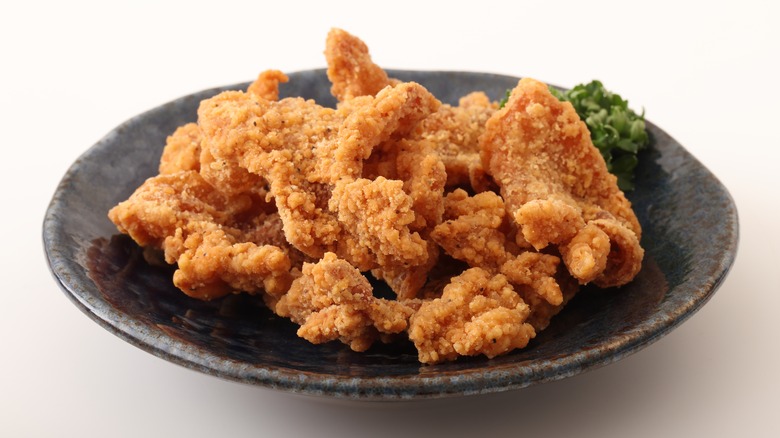The Step You Shouldn't Skip When Making Fried Chicken Skin
Few foods test our willpower like any kind of skin-on chicken, golden-brown, and steaming hot. There's something about the crispy, fatty, insanely aromatic skin that draws us in despite the possibility of burned fingers and dried-out meat. We're not alone in our weakness. People have been snacking on animal skin for a long time, and as Healthine reports, animal skin is zero-carb and rich in protein with a satisfying crunch. In the southern United States, you'll find pork rinds, which are boiled, dried, and puffed pork skins with the fat removed (per Healthline). In Spain, Mexico, and South America, there are chicharrones — fried, often meaty, bits of pork, beef, chicken, or mutton fat with the skin attached for cooking, says Britannica. And in Japanese sushi restaurants, you can find salmon skin appetizers and rolls. Families often fight over turkey skin on Thanksgiving and Jewish cuisine uses schmaltz: rendered chicken or goose fat (per Tablet Magazine).
So despite what conventional wisdom tells us about fatty fried foods being bad for your health, they certainly taste amazing and have consequently won the hearts of foodies worldwide. In a time when carb-heavy, processed junk food is under scrutiny, eaters are welcoming more natural, animal-based snacks. One such dish is fried chicken skin or "Jewish bacon." In Yiddish cuisine, they're known as gribenes and are the result of making schmaltz, Tablet Magazine writes. These irresistible savory morsels are simple to make at home — as long as you don't omit a crucial step.
Scrape the fat off first
First, you'll need an abundance of raw chicken skin. Jen Karetnick reports to J More Living (via The Nosher) that you can get it from chicken thighs as well as whole chickens — just be sure to work with it when it's still cold. Joshua Malina of Tablet Magazine recommends saving the trimmed skin from chicken whenever you make soup from scratch. The quality of the skin is important, and seek out sustainably and humanely raised chicken whenever possible. Specialty butcher shops and online purveyors who source farm-fresh chicken directly, like US Wellness Meats and Primal Pastures, may even stock chicken skin for you to order by the pound and have shipped to your home.
But when cooking the chicken skin, the most important step is to remove as much of the fat as possible. In his book, "Heritage" (via Serious Eats), Sean Brock of Husk says that one must scrape the fat off the skin before baking it to ensure ultimate crunchiness. If you've ever compared the scrumptious crispy glory of a roast whole bird to the soggy underside, you'll understand why it's worth the effort. Serious Eats editor Maggie Mariolis tested Brock's recipe and explains that cutting the skin into strips after you've scraped the fat is far easier than scraping the delicate, already-cut pieces.
Other uses for chicken skin and fat
Now that you've got your cooked chicken skins, there's a good chance you'll gobble them up before you have a chance to stop yourself, and no one can blame you. But if you're disciplined, Jen Karetnick recommends trying chicken skin cracklings as a stand-in for chips with dip, salad croutons, and even taco shells. Restaurants like Husk and The Smith serve them as bar snacks, often marinating them in buttermilk first. Ree Drummond likes hers simply seasoned with dried herbs. Alton Brown, culinary mad scientist that he is, cooks sheets of chicken skin in a waffle iron. You can prepare chicken skin in a stovetop pan, an oven, or even your air fryer.
And why not? In moderation, chicken skin is totally fine to consume. The Harvard School of Public Health reports that most of the fat in chicken skin is unsaturated fat, the so-called "good" fat that helps your heart by reducing blood pressure and cholesterol — but it's also high in potentially inflammatory omega-6s, so keep that in mind. You can reserve the fat you removed from the chicken skin for other culinary uses, like rubbing a whole chicken, making stuffing, cooking rice, spreading on toast, and even baking. Imagine adding a spoonful of rich, flavorsome poultry fat to your next dish when the cold weather hits! So next time you buy chicken, don't go for the skinned cuts. Utilize that precious skin and buttery-yellow fat to add an unforgettable dimension to your cooking.


